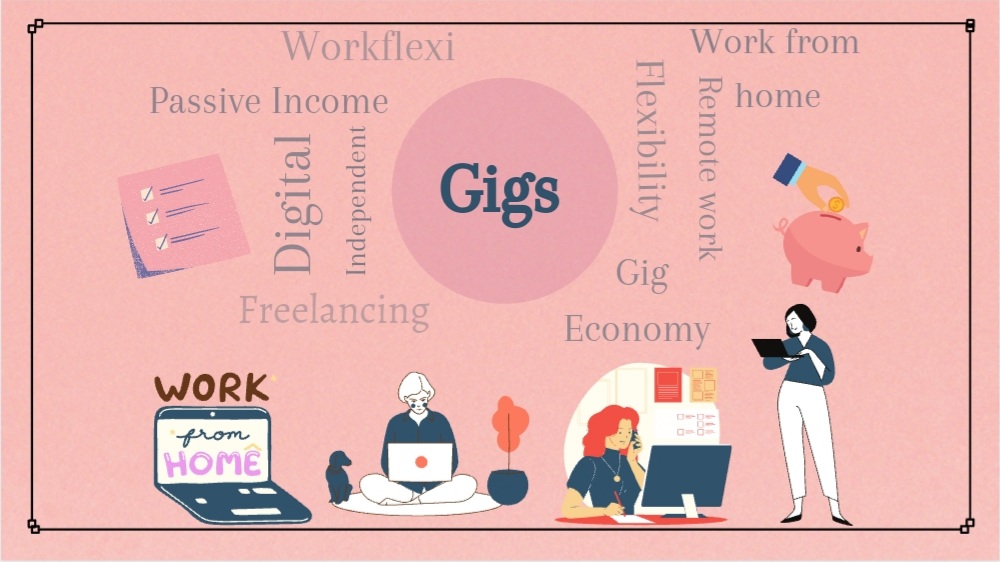The Future Of Gig Economy In India
What's the future of the gig economy in India?
India’s total manpower is around 500 million workers of which around 41% are employed in farming sectors and the remaining 59% (around 290 million workers) are in a non-farming sector which includes construction, manufacturing, retail, transport, and logistics.

For the non-farming sector alone, the Gig Economy in India has the future to transact around $250 billion in the amount of work. It can serve up to 90 million jobs, and additionally, add 1.25% to India’s Gross Domestic Product (GDP) in the longer term. (Source - Boston Consulting Group and Michael & Susan Dell Foundation)
India Isn't A New Entry To The Gig Economy
Gig work primarily means work done on demand within a stipulated time with little to no formal contracts signed by two parties. In that case, the informal economy in India (with lots of blue-collar jobs, daily wage workers) is not new to gig jobs. However, the gig jobs gained thrust in India after the success of platform-based companies like Ola (taxi & rikshaw service), Workflexi (technical, non-technical & creative service) Zomato (food delivery service).

The BCG report also mentions that the participation of the workforce in the gig economy is more in developing countries like India than in the developed countries. The report also predicts gig and platform-based jobs will evolve and a part of it will be for a highly skilled workforce. Even inside the sectors such as healthcare, small and medium businesses, the greater demand for highly-skilled gig workers in India is predicted in the coming years.
How Pandemic Has Helped Gear The Horns Of The Gig Economy In India?
Before the outbreak of the coronavirus and the start of the pandemic in the year 2020, the word “work” had a preset notion and certain conditions. For white collared profession, the office work before the pandemic meant doing the work sitting in office cabins away from home in some location. Almost everything was fixed right from the cabin to the office hours. Likewise, for the blue collared jobs based on the work they had fixed or mobile office locations.

But after the pandemic hit our lives, it threw the whole traditional office system into chaos, and the companies were forced to think differently to get their work done. Few organizations which were dependent on the public like malls, hotels ended up doing pay cuts, firing their employee’s as their main revenues took a big hit. Few small enterprises were also forced to shut their doors forever. On the other side, on a positive note, few of the fired employees started finding gigs and it also led people to learn new skills to take up the gigs to support their family and build a better quality of life.
Chunduru (founder of a business transformation organization) says, “the gig economy in India is in existence for a while now but previously it was known only for blue-collar jobs. Now the latest add-on to the Gig economy in India is the white-collar gig workers”. He mentions that three sets of companies are in requirement of white-collar gig workers. They are the startups, small and medium enterprises, and the third being the legacy companies who are revamping their strategies, business model and aiming for quicker growth.
He adds that the pandemic indeed saw a rising trend in the gig economy and also a change in the mindset of people. He gives an example of a startup founder who felt the gig economy was far from reality in India. Once the pandemic hit, he could see it being a reality. Pandemic has made abnormal things the new normal and one which gained more currency during this period was of course the gig economy.
Gigs Versus Traditional Employment
Apart from the pandemic, there are certain clear advantages that the gig economy has compared to traditional employment. A gig economy is cost-effective for companies as the hiring process will be based on the company’s requirements and business need for the stipulated time, this allows the company to save more on compliance costs which they would have to bear if they recruit employees permanently.

Gig economy suits the best for the companies or organizations whose business model is based on temporary workforce and their needs keep changing for every project. They are also ideal for startups for two reasons. The first reason is affordability. They get an option to hire highly skilled gig workers for a certain amount of time-based on a contract which can cost a fortune otherwise. The second reason is expertise level. Startups, since they hire skilled gig workers they can save money on training costs.
The other clear benefits are convenience, flexibility, quality work, and demanded payment for the work done on time. The hirer and gig worker can also have a mutually beneficial relationship as both of them are free to cater to their needs without any restrictions. In a nutshell, the rise in the gig economy in India will benefit employers, employees, and the economy in the long run.
Gig Workers Segment In India

The gig workers in India are divided into four segments:
- High Skills – They are very much aware of the work they are doing as they are pro at it. For example, developers, graphic designers, digital marketers, etc., fulfill the purpose and choose their flexible timings. Time flexibility helps women in taking care of their household commitments and also do the gig work in the available time.
- Moderate Skill – They want to make a mark in their field/career by improving themselves both position and learning-wise. The gig workers examples are Cab drivers, Auto drivers, LIC agents, Data Entry operators.
- Semi Skill – The skill level is low but they want to contribute financially, lend a helping hand to increase the household income. The gig workers examples are Construction workers, Food Delivery agents, Healthcare workers, Construction workers.
- Student – They earn to pay their fees, financially support their family, learn soft skills and a flexible schedule helps them take up gig work after their college.
Gig Economy And End-users
For end-users or consumers, gigs offer lots of benefits. For instance, in your daily life, before ride-sharing apps like Ola, Uber came in to picture renting a taxi was not a first choice you had while you wanted to travel without using your vehicle. Many traditional businesses have reduced their service charges to keep up with the competition of the gig economy. Quality and Trust have become an ardent part of the gig economy. The gigs have made our life more hassle-free and less worrisome from food delivery to software product delivery.
What Are The Components Required To Raise The Future Of Gig Economy In India To The Next Level?

According to Rajah Augustinraj (Principal, BCG), an ecosystem made of four distinct and interrelated components unlock the future of the gig economy.
- Platform and services – should ensure providing gig works to end users, fulfilling the pre-requisites from both sides, and have innovations in business model, offerings, and pricing.
- Ecosystem Enablers – providing commonly used services across the platform including skill development training, background verification, and financial services.
- Digital Public Goods – providing a set of community-owned content-based worker registries, skill repositories, and inventory to enable the transparency of demand and supply information.
- Government Public Policy and Regulation – The Government should pave way for the rising trend in Gig Economy by bringing in worker protection laws, covering occupational hazard benefits and coverage, and providing data privacy and security.
He concludes that India has all the components in place with different levels of maturity. Bringing in the full-fledged ecosystem of technology-based platforms, required service enablers, public goods, and public policy will bring in the momentum to raise the immense potential that the gig Economy holds for our country.
How Trustworthy Platforms Like WorkFlexi Are Helping The Cause?
Now the future of the Gig Economy in India has taken a big leap after the emergence of technology-enabled platforms like
Workflexi where gig works are available for the white-collared fraternity as well with more safeguarding policies in place. They provide the best platform for companies to get engaged with skillful gig workers to meet their demands and goals on time. Also on the other side, they make sure the gig workers earn their money based on the milestones achieved while performing a Gig.

The transparency and safety provided by gig platforms like Workflexi help the companies(hirers) and gig workers give their best. Here in Workflexi, the biggest advantage for a gig worker is on-time payments wherein on the other hand companies also get their quality work done on time. Such trustable platforms are the major contributors to the rise in the future of the gig economy, especially in India.
If you are talented and think you have the capability to do gigs you can register here. On the other hand, if you are a hirer and you want the best talents for your work, you can hire gig workers from Workflexi.
Conclusion Note
With the rise of the gig economy, India is predicted to be gigantic with the business transformation happening around the world. Gig Economy could create 1 million new jobs in the next 2-3 years and provide livelihoods to millions of Indian people in the area of their expertise. It's high time that all skilled professionals get adapted to the gig working as it's going to become the new normal in the future.
 For the non-farming sector alone, the Gig Economy in India has the future to transact around $250 billion in the amount of work. It can serve up to 90 million jobs, and additionally, add 1.25% to India’s Gross Domestic Product (GDP) in the longer term. (Source - Boston Consulting Group and Michael & Susan Dell Foundation)
For the non-farming sector alone, the Gig Economy in India has the future to transact around $250 billion in the amount of work. It can serve up to 90 million jobs, and additionally, add 1.25% to India’s Gross Domestic Product (GDP) in the longer term. (Source - Boston Consulting Group and Michael & Susan Dell Foundation)
 The BCG report also mentions that the participation of the workforce in the gig economy is more in developing countries like India than in the developed countries. The report also predicts gig and platform-based jobs will evolve and a part of it will be for a highly skilled workforce. Even inside the sectors such as healthcare, small and medium businesses, the greater demand for highly-skilled gig workers in India is predicted in the coming years.
The BCG report also mentions that the participation of the workforce in the gig economy is more in developing countries like India than in the developed countries. The report also predicts gig and platform-based jobs will evolve and a part of it will be for a highly skilled workforce. Even inside the sectors such as healthcare, small and medium businesses, the greater demand for highly-skilled gig workers in India is predicted in the coming years.
 But after the pandemic hit our lives, it threw the whole traditional office system into chaos, and the companies were forced to think differently to get their work done. Few organizations which were dependent on the public like malls, hotels ended up doing pay cuts, firing their employee’s as their main revenues took a big hit. Few small enterprises were also forced to shut their doors forever. On the other side, on a positive note, few of the fired employees started finding gigs and it also led people to learn new skills to take up the gigs to support their family and build a better quality of life.
Chunduru (founder of a business transformation organization) says, “the gig economy in India is in existence for a while now but previously it was known only for blue-collar jobs. Now the latest add-on to the Gig economy in India is the white-collar gig workers”. He mentions that three sets of companies are in requirement of white-collar gig workers. They are the startups, small and medium enterprises, and the third being the legacy companies who are revamping their strategies, business model and aiming for quicker growth.
He adds that the pandemic indeed saw a rising trend in the gig economy and also a change in the mindset of people. He gives an example of a startup founder who felt the gig economy was far from reality in India. Once the pandemic hit, he could see it being a reality. Pandemic has made abnormal things the new normal and one which gained more currency during this period was of course the gig economy.
But after the pandemic hit our lives, it threw the whole traditional office system into chaos, and the companies were forced to think differently to get their work done. Few organizations which were dependent on the public like malls, hotels ended up doing pay cuts, firing their employee’s as their main revenues took a big hit. Few small enterprises were also forced to shut their doors forever. On the other side, on a positive note, few of the fired employees started finding gigs and it also led people to learn new skills to take up the gigs to support their family and build a better quality of life.
Chunduru (founder of a business transformation organization) says, “the gig economy in India is in existence for a while now but previously it was known only for blue-collar jobs. Now the latest add-on to the Gig economy in India is the white-collar gig workers”. He mentions that three sets of companies are in requirement of white-collar gig workers. They are the startups, small and medium enterprises, and the third being the legacy companies who are revamping their strategies, business model and aiming for quicker growth.
He adds that the pandemic indeed saw a rising trend in the gig economy and also a change in the mindset of people. He gives an example of a startup founder who felt the gig economy was far from reality in India. Once the pandemic hit, he could see it being a reality. Pandemic has made abnormal things the new normal and one which gained more currency during this period was of course the gig economy.
 Gig economy suits the best for the companies or organizations whose business model is based on temporary workforce and their needs keep changing for every project. They are also ideal for startups for two reasons. The first reason is affordability. They get an option to hire highly skilled gig workers for a certain amount of time-based on a contract which can cost a fortune otherwise. The second reason is expertise level. Startups, since they hire skilled gig workers they can save money on training costs.
The other clear benefits are convenience, flexibility, quality work, and demanded payment for the work done on time. The hirer and gig worker can also have a mutually beneficial relationship as both of them are free to cater to their needs without any restrictions. In a nutshell, the rise in the gig economy in India will benefit employers, employees, and the economy in the long run.
Gig economy suits the best for the companies or organizations whose business model is based on temporary workforce and their needs keep changing for every project. They are also ideal for startups for two reasons. The first reason is affordability. They get an option to hire highly skilled gig workers for a certain amount of time-based on a contract which can cost a fortune otherwise. The second reason is expertise level. Startups, since they hire skilled gig workers they can save money on training costs.
The other clear benefits are convenience, flexibility, quality work, and demanded payment for the work done on time. The hirer and gig worker can also have a mutually beneficial relationship as both of them are free to cater to their needs without any restrictions. In a nutshell, the rise in the gig economy in India will benefit employers, employees, and the economy in the long run.
 The gig workers in India are divided into four segments:
The gig workers in India are divided into four segments:
 According to Rajah Augustinraj (Principal, BCG), an ecosystem made of four distinct and interrelated components unlock the future of the gig economy.
According to Rajah Augustinraj (Principal, BCG), an ecosystem made of four distinct and interrelated components unlock the future of the gig economy.
 The transparency and safety provided by gig platforms like Workflexi help the companies(hirers) and gig workers give their best. Here in Workflexi, the biggest advantage for a gig worker is on-time payments wherein on the other hand companies also get their quality work done on time. Such trustable platforms are the major contributors to the rise in the future of the gig economy, especially in India.
If you are talented and think you have the capability to do gigs you can register here. On the other hand, if you are a hirer and you want the best talents for your work, you can hire gig workers from Workflexi.
The transparency and safety provided by gig platforms like Workflexi help the companies(hirers) and gig workers give their best. Here in Workflexi, the biggest advantage for a gig worker is on-time payments wherein on the other hand companies also get their quality work done on time. Such trustable platforms are the major contributors to the rise in the future of the gig economy, especially in India.
If you are talented and think you have the capability to do gigs you can register here. On the other hand, if you are a hirer and you want the best talents for your work, you can hire gig workers from Workflexi.



